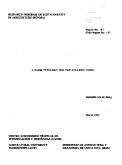| dc.contributor.author | Steeg, J. van de | |
| dc.date.accessioned | 2014-10-17T05:32:14Z | |
| dc.date.available | 2014-10-17T05:32:14Z | |
| dc.date.issued | 1997 | es_ES |
| dc.identifier | 352327 | es_ES |
| dc.identifier.uri | https://repositorio.catie.ac.cr/handle/11554/39 | |
| dc.description | 56 pág, 10 ilus, 28 tab. 31 ref. También como: Field Report - Atlantic Zone Programme (CATIE) no. 157 | es_ES |
| dc.description.abstract | In land use analysis it is often necessary to generalize individual farMON into a number of farm types. In this research the farm typology is based on the physical production possibilities presented by farm size and soil group. For the Atlantic zone of Costa Rica the location of farMON at regional level is unknown and additionally the small scale soil map contains many soil associations. This report deals with these probleMON and presents a procedure to perform a farm typology. Special attention is given to soil variation with farMON and to functional soil grouping. To perform a farm typology, first of all the farm sizes have to be known. Farm sizes are based on the land use zone map. For each land use pattern the distribution of farMON is calculated, so the number of farMON for specific mapping units are known. The farm sizes are calculated by dividing the area of a mapping unit by the number of farMON. Next the belonging soil groups have to be determined. The original soil map identified 75 different soil series. To deal with the enormous amount of alternative land use systeMON, that result from combinations of soil type, crops and management, the soil map is simplified. The simplified soil map describes different soil groups of a mapping unit as a soil association. The farm typology is based on the prevailing soil of this association. When the farm typology is performed, the variation of soils within farMON is examined. An approximate distribution of the variation in a farm is given by the soil association. The utilized soil for the farm typology is therefore a good indicator. At last specific attention is given to functional soil grouping. With the aid of simple transfer functions, biocide leaching and soil fertility are studied for the soils of the Atlantic Zone. The results of these transfer functions are added to the outcome of the Costa Rican land evaluation system and are used to determine a functional soil grouping. The Costa Rican land evaluation system is used to determine the suitability of soils for a certain land use with low erosion risks and sustained productivity. Additionally taken into account, soil fertility and biocide leaching make it possible to study environmental aspects. | es_ES |
| dc.language.iso | en | es_ES |
| dc.publisher | CATIE, Turrialba (Costa Rica). Atlantic Zone Programme Agricultural University Wageningen, Wageningen (Países Bajos) Ministerio de Agricultura y Ganadería, San José (Costa Rica) | es_ES |
| dc.relation.ispartof | Report - Atlantic Zone Programme / CATIE-AUW-MAG ; número 117. | |
| dc.subject | COSTA RICA | es_ES |
| dc.subject | EXPLOTACIONES AGRARIAS | es_ES |
| dc.subject | GENESIS DEL SUELO | es_ES |
| dc.subject | DRENAJE | es_ES |
| dc.subject | FERTILIDAD DEL SUELO | es_ES |
| dc.subject | UTILIZACION DE LA TIERRA | es_ES |
| dc.subject | TIPOLOGIA DE GRANJAS | es_ES |
| dc.subject | EVALUACION DE TIERRAS | es_ES |
| dc.title | A farm typology for the Atlantic Zone | es_ES |
| dc.type | Libro | es_ES |


